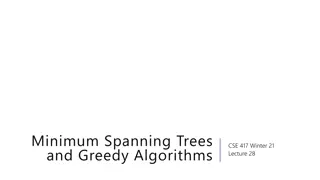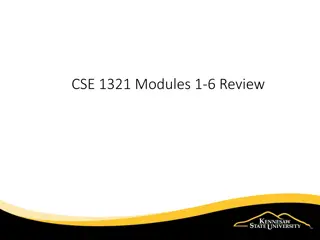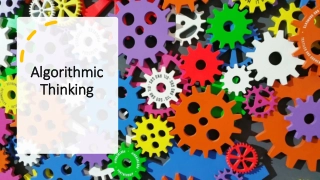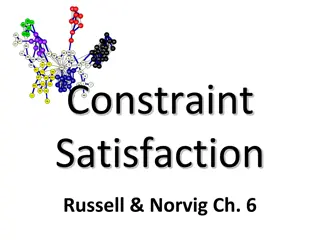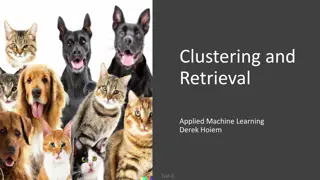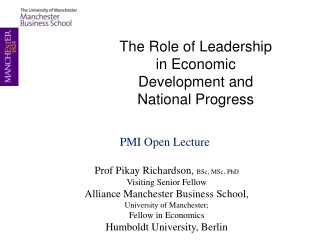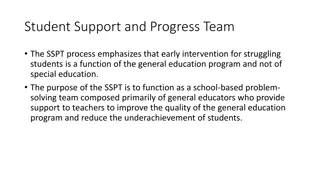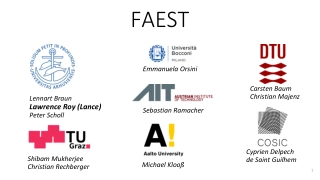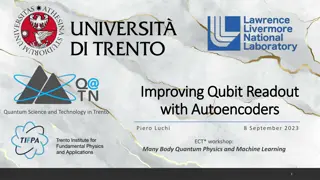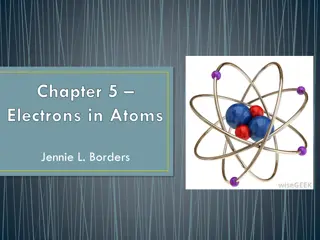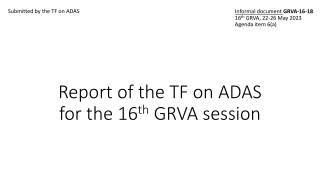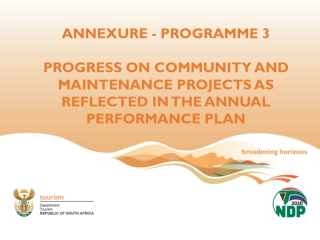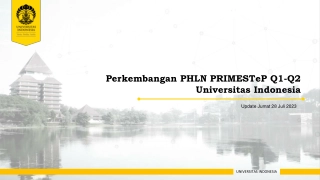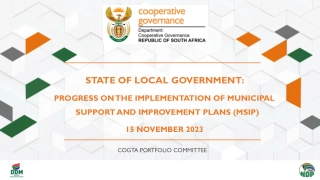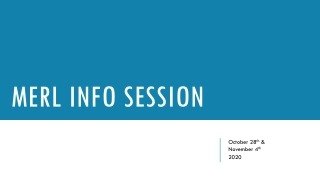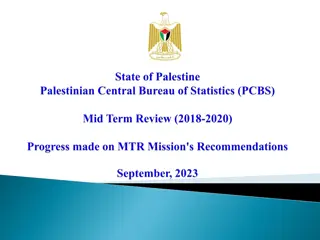PASQAL: QML Progress Panagiotis Barkoutsos, VP Quantum Algorithms
Discover the latest progress of PASQAL Quantum as Panagiotis Barkoutsos, VP Quantum Algorithms, presents the advancements in quantum technologies. This confidential update highlights the company's achievements in qubit count, global engagements, and their full-stack solution.
Download Presentation
Please find below an Image/Link to download the presentation.
The content on the website is provided AS IS for your information and personal use only. It may not be sold, licensed, or shared on other websites without obtaining consent from the author. Download presentation by click this link. If you encounter any issues during the download, it is possible that the publisher has removed the file from their server.
- PASQAL
- QML
- progress
- Panagiotis Barkoutsos
- VP Quantum Algorithms
- quantum technologies
- qubit count
- full-stack solution
Presentation Transcript
PASQAL : QML Progress Panagiotis Barkoutsos, VP Quantum Algorithms QTML November 2023 1 Strictly private and confidential. Not for distribution.
PASQAL at a Glance >20 >20 40 40 350+ 350+ CLIENTS YEARS QUBITS Multiple QPUs sold via HPCQS framework, activities in more than 10 countries, and engagements with top cloud distributors History in quantum technologies Best-in-class qubit count and path to 10,000 qubits available in the cloud in 2026 200+ + 200 15+ 15+ FULL FULL- -STACK STACK EMPLOYEES 18 nationalities PATENTS & APPLICATIONS 800+ publications QUANTUM HARDWARE AND SOFTWARE TODAY Aiming for Practical Quantum Advantage 2 Strictly private and confidential. Not for distribution.
PASQAL Hardware PASQAL manufacturers industrialized neutral scaling, flexible topology and analog and digital computational mode PASQAL manufacturers industrialized neutral- -atoms type quantum processors offering attractive scaling, flexible topology and analog and digital computational mode atoms type quantum processors offering attractive laser camera 2D acousto-optic laser beam reflector vacuum chamber dichroic mirror Currentlyavailable systemsare in the order of 300+ qubits optical clamp Hardware control electronics Clear blueprint to showcase 1000 qubits in near- term Analog and analog-digital capabilities Development of Algorithms and Solutions 3
Our Full-Stack Solution is Key to Driving Customer Success PASQAL s comprehensive full-stack offer covers the full range of needs from the quantum computer hardware to the way to use it on personalized software on use cases Hardware Hardware1 1 Offerings Offerings Cloud access Data center install On-premise install Access Access Gen 1 Gen 2 Coding platform GUI Software integrations 100 / 200-Q 512 / 1,024-Q Platform Turnkey solutions per problem and sector Chemistry, CFD2, Finance Solutions Gen 3 5,000 / 10,000-Q and beyond Quantum (ready) algorithms per mathematical problem PDE, optimization, ML Libraries R&D support Tech support Maintenance GPU Cluster GPU Cluster Emulator Support [1] Q represents qubits [2] CFD represents computational fluid dynamics 4 Strictly private and confidential. Not for distribution.
Merger PASQAL <> Qu&Co for application-driven Research Application-driven in-house quantum algorithm research In January 2022, PASQAL announced merging with quantum software startup Qu&Co Accelerating research and the road towards quantum advantage by combining HW technology & problem orientations Hardware Software 1-2 years earlier Technology- driven Problem- oriented 5 Strictly private and confidential. Not for distribution.
PASQALS Mission We want to make the world and industry quantum solutions quantum- -ready solutions for their most valuable problems. ready, and develop concrete quantum quantum At the same time, we are eager to research towards quantum advantage can have to our socio-economic world. quantum advantage and the impact it 6 Strictly private and confidential. Not for distribution.
Where do we see quantum advantage in the near future? Computational Advantage will arise in the design of quantum solutions (and algorithms) for classically hard problems and use cases with relevance to our world. Use Cases with relevance to the industry and the socio-economic world Quantum Advantage Candidates Current Technologies 300+ Physical Qubits are available Classically Hard Problem Fault Tolerance is still a regime to be explored Relevant solution takes too much time if feasible Error Mitigation Techniques Use Case has an impact for our world Some sort of advantage can be demonstrated Have a benchmark (at least in smaller scale) Accuracy and Precision should not be mixed ! Accuracy and Precision should not be mixed ! We care for both (at least in most cases!) 7 Strictly private and confidential. Not for distribution.
Application: Quantum Simulation for Scientific discovery Analog Quantum Simulation are already operating in a regime going beyond the capabilities of classical supercomputers Staggered magnetisation histograms for 10 10 and 14 14 arrays, with MPS shown on the lower part of the 10 10 array (14 days for simulation with TeNPy). 8 Strictly private and confidential. Not for distribution.
Application: Learning on Graph-structured data Graph Machine Learning offers a QML opportunity native to reprogrammable neutral atoms Quantum procedures go beyond classical means. Geometry induced by the quantum procedure cannot be efficiently reproduced by classical means Neutral atom arrays enable native implementations of graph machine learning techniques 0.300 0.175 0.250 0.150 0.200 0.125 Probability Probability 0.100 0.150 0.075 0.100 0.050 0.050 0.025 0.000 0.000 -15-10-5 0 5 10 15 20 Energy value -15-10-5 0 5 10 15 20 Energy value 9 Strictly private and confidential. Not for distribution. Source: Work in Progress + Quantum evolution kernel : Machine learning on graphs with programmable arrays of qubits , Louis-Paul Henry, Slimane Thabet, Constantin Dalyac, Lo c Henriet, Phys. Rev. A 104, 032416 (2021)
Application: Enhancing classical graph ML with quantum features Graph Machine Learning could benefit from quantum correlations[1] Aggregation weights are computed using the long- range correlations of a quantum system Quantum Graph Feature maps encode graph into Hilbert space and correlation matrices are observed 10 Strictly private and confidential. Not for distribution. [1] Extending Graph Transformers with Quantum Computed Aggregation , Slimane Thabet, Romain Fouilland, Loic Henriet, https://arxiv.org/abs/2210.10610 (2022)
Application: Solving Non-Linear Partial Differential Equations DQC DQC is a variational approach, where parametric functions are represented by measurements on the output of quantum circuits The upper part describes the structure of a classical neural network, while the lower part describes the structure of DQC The neural network is essentially a non-linear function generator which, given an input x, produces an output f(x). One trains the NN to represent the function that solves a DE given boundary conditions. At a given step, a loss function is evaluated and an update of the NN weights is decided in order to improve the quality of the output. One very important ingredient here is automatic differentiation, which allows you to not only have access to f, but also to the derivative of f with respect to x What we proposed for DQC is to use a quantum circuit to produce a universal function generator, similar to the classical case, sometimes also called a Quantum Neural Network or Quantum Model The analogue of the NN consists of a quantum circuit. Very much like automatic differentiation for classical neural networks, there are ways to access function derivatives through analytical circuit differentiation PINN[1] Variationally update the NN weights Automatic differentiation through backpropagation ? ?(?) Hidden layers Output Input Compare with loss- function constructed from diff.equ. and boundary conditions PINN[1]with comparable performance as DQC would need up- to O(2N) nodes with high connectivity ? ?? ?? ?(?) ?? ??= ?2+ sin ? + ? up to 2Nbasis functions for fitting f(x) and df/dx ? 0 = 5 Circuit differentiation | 0 | 0 | 0 | 0 ?? ? ?? (Xi) = Update variational parameters of the quantum circuit | 0 | 0 DQC[2] measure ?(??) = ??? ??(?? ) quantum feature map circuit variational quantum circuit 11 Strictly private and confidential. Not for distribution. [1] Solving nonlinear differential equations with differentiable quantum circuits https://arxiv.org/abs/2011.103955 Phys. Rev. A 103, 052416 (2021)
Digital / Analog setups provide a promising solution for DQC implementation Digital / Analog Quantum Computation Digital discrete Digital: algorithm implemented through sequence of discretequantum gate operations Digital entanglers Analog parameters and the quantum computer evolves towards an answer continuously Analog: user has control over small number of Original (fully digital) DQC circuit continuously[2] Digital is universal short gate sequences potential for quantum advantage universal, but noise limits the use to very short gate sequences, which limits the near-term very Quantum feature map Digital variat, gates Digital variational gates Measurement Optimized (analog-digital) DQC circuit Analog is perhaps not fully universal researchers are finding that it requires typically 10 10 not fully universal, but 104 4- - 105 5less quantum operations less quantum operations Analog entanglers Analog quantum (or analog-digital) may therefore very well be our best chance to implement DQC workflows to implement DQC workflows 12 Strictly private and confidential. Not for distribution.
Application: Quantum (Scientific) Machine Learning (QSciML) QML with Digital-Analog QNN circuits for simulating systems governed by Differential Equations Solving known deterministic equations (PDE) Differential Constraints Help Train Generative models Optimizing control/model parameters to maximize solution characteristics of merit Learning DE-models based on real-world data [1] Solving nonlinear differential equations with differentiable quantum circuits https://arxiv.org/abs/2011.103955 Phys. Rev. A 103, 052416 (2021) [2] Protocols for Trainable and Differentiable Quantum Generative Modelling https://arxiv.org/abs/2202.08253 [3] Quantum Extremal Learning https://arxiv.org/abs/2205.02807 [4] Quantum Model Discovery https://arxiv.org/abs/2111.063766 13 Strictly private and confidential. Not for distribution.
From Analog applications to Digital-Analog paradigms Pulse-level Control Paradigms Digital-Analog Analog With Analog quantum computing, we mean continuous control of our system Hamiltonian by the application of optical addressing with laser light As an example, we can operate our quantum optical system in the Ising model regime, where the parametric Hamiltonian can be described as In a digital-analog paradigm, we define it as digital operations, such as arbitrary single-qubit gate(s)/rotations, interleaved with global multi-qubit operations such as evolution over an Ising Hamiltonian. This allows efficient entanglement at low circuit depth, while simultaneously allowing more specific control of individual rotations 14 Strictly private and confidential. Not for distribution.
Where to go next in QML? What challenges are to be tackled? Pulse-level Control Paradigms Quantum Advantage of Quantum Neural Networks over classical (Deep) Neural Networks? (Analog) circuit differentiation is too expensive! How can we do practical gradient descent? We, as part of a broader community on the topic, have also developed extensions of the parameter shift rule towards more general unitaries including analog blocks Several papers which use expressivity arguments to claim a theoretic advantage over classical Classical neural networks were only very recently understood more rigorously theoretically is it simply too early to expect the same here? Do we need a quantum computer to understand a quantum computer? Recent work has expanded further on these, including explicity formulations for analog evolutions. However, for optimization based on gradient descent, the cost compared to backpropagation is simply too high to be practical Several papers pointing out limitations of QNN and QML in general, but often it is not clear how broadly applicable the statements are, and no clear solutions exist yet Open questions Can we train classically? Can we train more cheaply? Stochastic? 15 Strictly private and confidential. Not for distribution. [1] Generalized quantum circuit differentiation rules https://arxiv.org/abs/2108.01218 Phys. Rev. A 104, 052417 (2021)
Thank you! We are hiring in a variety of seniority levels: panagiotis.barkoutsos@pasqal.com 16 Strictly private and confidential. Not for distribution.









